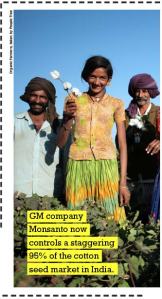In my last post, Marci Zaroff shared with us her knowledge about the toxic environmental impact of the textile industry, and today, we turn to the devastating human impact. Up to 77 million cotton workers suffer poisoning from pesticides each year, and in India, 300,000 cotton farmers have committed suicide—almost 26 a day—to escape debt.
Nadia: So, could you expand a bit more on what is being referred to as a ‘pesticide treadmill?’
Marci: So here are the hard facts. Just as germs infest on people who are weaker, when plants are sprayed with chemicals, they also get weaker. And then the soil weakens, and the eco-system isn’t building a healthy plant. So this ultimately results in less yield for the farmer.
And then, these bugs build resistance to these pesticides, and the farmers have to buy stronger and more expensive pesticides, which they can’t afford, so they have to leverage their farms to the banks. Then, as the cycle perpetuates and continues, the soil gets depleted & destroyed, the bugs get out of control, and the farmers can no longer sustain their livelihoods. Stuck in tremendous debt, many farmers are committing suicide with the very pesticides that they used on their plants. Every half an hour in India, a farmer is committing suicide. There’s an upcoming documentary called Dirty White Gold that will reveal what is now being referred to as this ‘pesticide treadmill.’
Nadia: I just read that genetically modified crops are decreasing pesticide use for farmers, is this true?
Marci: While there may be artificial decrease in the pesticides use in the short-term, in the long term we’re already seeing an increase in pesticide use again, because of genetic resistance and falling crop yields. Over 90% of the world’s cotton is now genetically modified (GMO), which has resulted in a monopoly for Monsanto, giving them the power to dramatically raise the prices on GMO cotton seed and the additional inputs and pesticides, which they also provide. At the mercy of these altered and chemical inputs, the GMO paradigm is not sustainable financially for farmers, and further, we are just beginning to learn of the harmful ramifications of GMO seeds in relation to human health. In addition, monocropping with GMO seeds is not only depleting the soil and its ecosystems, but risking the very survival of thousands of natural cotton varieties as well.
Nadia: And I just read that in the last year, the costs of cotton cultivation has jumped due to the rising costs of these pesticides, so it’s not as profitable as it used to be? And supposedly there have been more suicides among the farmers that have used these GM crops …
Marci: YES, these are sad facts, as stated prior.
Nadia: So you told us yesterday how organic cotton helps the earth, how does it help farmers?
Marci: Well first of all, there’s a risk with using GMO seeds. We are continuing to learn of the consequences of GMO, across many agricultural crops (food & fiber), which is why there is a huge movement towards GMO labeling in the USA. We are one of the only developed countries in the world that doesn’t require GMO labeling! On the contrary, since organic farming prohibits the use of any GMO seeds, organic farmers are allowed to work with their environment and economic situation in a sustainable way, while building and protecting their soil and farms. They also can diversify their crops, which allows them to diversify their income. If they have more than one crop to rely on, then it helps protect them in case there is a crop failure, market demand, etc. And of course, they don’t have to breathe in toxic pesticides that harm more than 77 million cotton farmers a year. It is devastating to see conventional cotton farmers walking thru their fields with pesticide tanks on their backs, not realizing that they are spraying poisons in their own faces. And even worse, often in the faces of their babies, who they are carrying in slings while walking their farms. They are often lured in by the seed and chemical companies. It is a tragic human situation that we can help to change by supporting the growth and market for organic cotton.
Nadia: I know you were instrumental in helping Fair Trade USA develop the first USA Fair Trade certification of textiles and will be spearheading their national launch in 2013. (Fair Trade farmers receive a minimum price for their product, covering the cost of production, with a Fair Trade premium paid in addition for investments in social, environmental or economic development projects). Could you explain a) what drives your passion for Fair Trade, and b) How it connects with your environmental/organic concerns and advocacy?
Marci: I am passionate about building community and connecting humanity. I believe it is extremely important to be in touch with the people who grow, sew and receive our products.

Nathuram Pal, a 45-year-old farmer of Bundelkhand region, committed suicide when he couldn’t pay the loan of Rs 12,000 taken from the coopertive bank and another Rs 40,000 taken from the local people (Full article here).
When you look at the triple bottom business model, which is ‘people, planet, profit,’ in textiles, much of the attention has been put on planet. But, as the example of the Indian farmers demonstrates, it’s also about people. When you start to work with people, the environmental ramifications are serious because they are being exposed to the toxins, and they can’t sustain their livelihoods. They can’t afford to feed their families. The cycle of fast fashion has driven costs down so low, that consumers only want extremely cheap clothing. So the question is, how do we create a more efficient supply chain where farmers can share grievances and are paid fairly? Where American consumers can understand that their clothing isn’t growing & made in their department store, but instead that people’s lives are being affected by the products and brands they are buying and supporting?
What Fair Trade does is to create an account for these farmers and/or factory workers so that they have a forum to voice their concerns. Marry that with the orders that the USA companies are placing. When you add the Fair Trade premium to the account, the farmers and/or workers can be paid “bonuses” that equate to a living wage, while also using their funds to invest into important and much needed community development initiatives such as education and health care.
And Fair Trade and Organic definitely compliment each other because not only are farmers getting paid more, their health is also being protected from the adverse effects of chemical pesticides and fertilizers, and they don’t have to pay the extra money on these pesticides. Nearly half of Fair Trade Certified products that were imported into the USA in the last few years were certified organic.

Organic cotton farmers in India don’t have to worry about pesticides damaging their health. India is the largest supplier of organic cotton, accounting for 80% of global production.
Nadia: What does the Fair Trade USA Garment and Textile certification ensure?
Marci: It protects both cotton farmers and/or factories from wage exploitation and terrible working conditions. A new model for living wages has been built in on top of the basic social standards (no child labor, fair working conditions, etc.) that have already been implemented by many USA companies. Farms and factories are checked periodically. It gives them premiums (funds) that are for community and social investment. So let’s say a company in the USA, like Under the Canopy, for example, bought Fair Trade Certified items from an Indian factory for $100. We would pay a percentage—somewhere between 5-10%- into a fund that the workers would control. Then, as a collective, the workers would decide where to invest their money—in health care, the building of a school, child care, etc. We would then, in turn, be able to monitor and measure these specific impacts, to communicate back to our customers and loyal consumers. It is our job to offset some of those premiums in other creative ways, such as enhanced design, product innovation, and by creating efficiencies in our supply chain.

For Fair Trade flower farmers in Ecuador, the Fair Trade premium supports education for their children (photo courtesy of oneworldflowers.org).
Nadia: I recently read that Fair Trade cotton is grown by 37 certified cotton farmer groups in 10 countries, and that in Mali, 95 percent of children of Fair Trade farmers go to school, which is more than double the national average for school attendance in a very poor country.
Marci: Yes, buying and supporting Fair Trade Certified products is truly affecting positive change in the lives of others in our global community. When I am in these projects, with the farmers and workers making our products, I am fueled by these efforts towards social justice, knowing that “like water for chocolate”, the happy energy of our growers and/or makers is in the soul, or DNA, of my brands.
Nadia: One of the really cool things about companies that work with fair trade artisans is that they absorb the costs of any discounts they may be having. Like, I can get a ring 25% off, and the artisan is still paid in full.
Marci:
Farmers and factory workers shouldn’t have to suffer when other people win.
But that’s how the current system works. We have to look at every way we can support farmers and factory workers. The minimum wage isn’t enough to sustain a family of four in most countries, so these efforts will support our partners’ basic needs (which is different for each country.) With the recent fire in the Bangladesh apparel factory where over 112 workers died due to poor working conditions, it is clearly imperative that we protect our fellow humanity.
Also, while I think Fair Trade is essential, if our cultural tendency is for faster, cheaper, “more” consumption, it will remain a challenge to balance market demand with a more sustainable model. Education & awareness are paramount and the time is NOW.
The impact of organic cotton farming and Fair Trade on people’s lives:
Additional Resources:
- Want to learn more about Fair Trade? Here’s a primer.
- Want to see how Indian farmers are growing organic cotton on their farms? Click here.
- Need help finding brands that use organic cotton? Check out this link.
- Organic cotton grown in the United States? Watch here.
My Related Posts:




Great post Nadia!
insightful and in-depth
Thank you so much, I really appreciate it!! 🙂 Please stay tuned for more of this series!
Nadia, tha ks for your reporting! What can I do to help change the situation? What do you think about the slow living movement? It will have its second conference in Brattleboro VT, May 2013, I want to speak there on the topic of textiles. Do you think its a good idea? Do we have an organized public textile awareness campaign?
Hi Leonore!
Thanks for your comment! I am going to write about the slow fashion movement in a future post, but I think that sounds like a great idea! 🙂
Pingback: ABAN: Empowering Girls in Ghana, One Fabric at a Time | Listen Girlfriends!
Nadia, Thank you for investing so much time & energy to report on these matters.
Of course Rodney!! This is what I am doing my research on too, so I am educating myself as well! 🙂
Pingback: Ethical Fashion: How to Navigate the Industry | Listen Girlfriends!
I am a new addict to your blog! I am loving everything you post! Look out for an email from me today!
God bless,
Christine
http://www.beyoutifulhope.blogspot.com
http://www.bloggersagainstsocialinjustice.blogspot.com
Aww, thank you so much!! That really means so much. Very excited to connect with you!! 🙂
Pingback: The Environmental and Ethical Issues Of Natural Fabrics